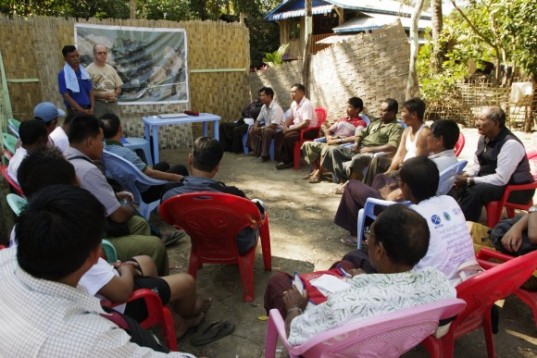Myanmar, and especially Rakhine State, is part of the most disaster-affected regions in the world in terms of frequency, scale, and severity, and is particularly negatively impacted by tropical cyclones and floods. In 2015, cyclone Komen made landfall in Northern Rakhine State, resulting in massive floods and landslides, exacerbating the monsoonal flooding.
Coupled with overall underdevelopment, reoccurring conflicts, and low resilience, the population in Rakhine State is extremely vulnerable to changes in weather patterns and are often ill-prepared to withstand the impact of disasters. Strengthening populations’ resilience to natural disasters is one of the priorities for ACTED in Myanmar.
One method to mitigate risks of natural disasters is to ensure the conservation and rehabilitation of mangrove plants. Mangroves offer an essential source of protection against the effects of natural hazards and erosions because they serve as a buffer against strong winds, storm surges, and tsunamis. Beyond protection, mangroves provide a home to dozens of different types of fish, birds, and small animals, in addition to being a source of food and livelihood for fishermen and local communities.

However, there is a growing challenge of mangrove conservation in Rakhine State. Existing mangrove forests lack legal protection and are often used by local communities as a source of firewood and food for livestock, leading to their degradation. Indeed, a study from November 2015 conducted by ACTED’s partner REACH indicated that, across Rakhine State, mangrove coverage shrank by 23% from 2000 to 2015. Consequently, as mangrove coverage decreases, the vulnerability of local communities increases.
Informing about mangrove regeneration techniques and disaster risk reduction
Given the context in the city of Sittwe, the capital of Rakhine State, and in order to educate local communities and community-based organisations on the necessity for mangrove conservation, ACTED and its partner Mangrove Action Project (MAP) conducted a series of trainings known as Community-Based Ecological Mangrove Restoration (CBEMR). CBEMR training is an alternative mangrove restoration technique in which local communities are encouraged to facilitate the natural regeneration of mangroves by restoring and improving their local hydrology and topography. Training participants included local government, local NGOs, and civil society organisations which then took part in the restoration of two demonstration plots to put what they learned into practice.

The CBEMR training and demonstration plots were part of an on-going project by ACTED with partner International Organization for Migration (IOM) in Sittwe. This programme for improved disaster management and resilience against natural disaster in Rakhine, emphasises disaster risk management, resilience, and the importance of mangroves in mitigating natural disasters.